Review and photos by Bokisaurus
Today, we will review a special figure. I originally intended this as my first 2019 review but got delayed. I wanted to review something a little different than your mass produced toy figures, this was the perfect candidate.
As a kid, my fondest memories of going to the zoo was seeing the giraffes. Like many kids, I was amazed by how beautiful and big they were, and how much they resembled by favorite group of dinosaurs, the sauropods. No other extant animal comes close to resembling the sauropod than the giraffes, with their long necks and incredible hight.
As an adult, I worked in a zoo for many years. During my time at the zoo, I was lucky fortunate to have the opportunity to visit and observe the family of giraffe whenever I want. I was also lucky enough to have been given rare opportunity to see them up close, behind the scenes.
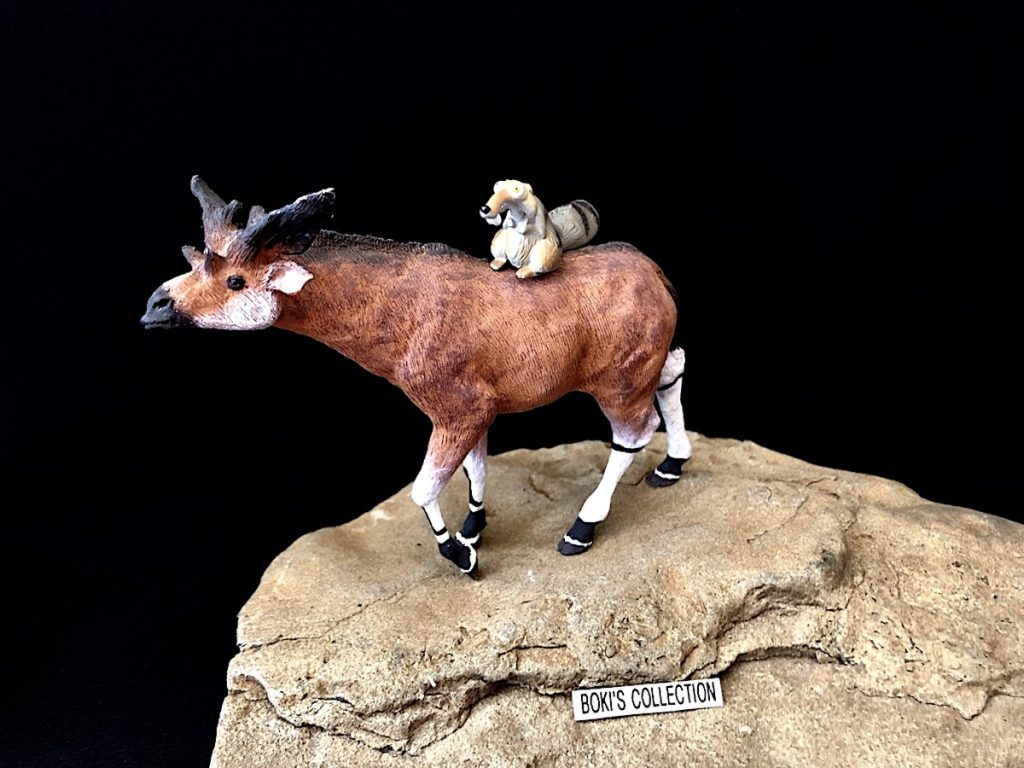
When we think of giraffes, the image that comes to mind is that of a large animal with long legs and even longer necks. But like many of todays extant animals, giraffes were a product of long evolution and belong to a much larger and diverse family that came in all size and shapes.
Today, the family Giraffidae only have two living members, the giraffe and the Okapi, both found in Africa. But back in prehistoric times, there were many different species.
Today, we will take a look at one of them, the mighty Sivatherium.
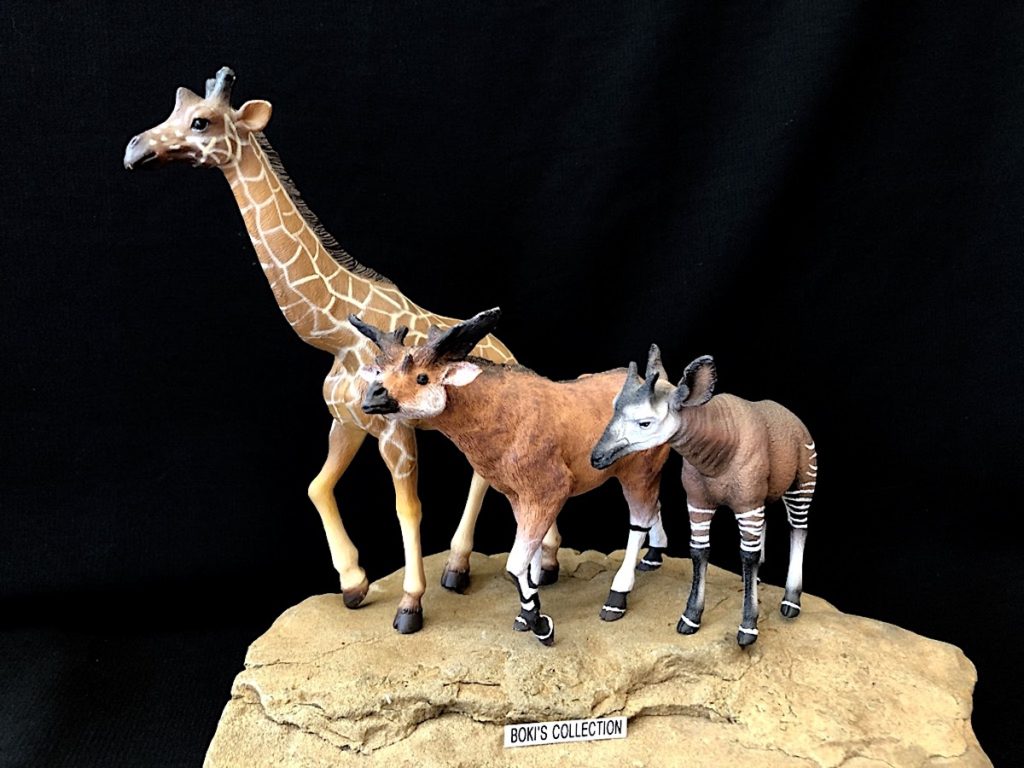
I have to admit that not too long ago, I was pretty much oblivious to the different extinct species of giraffes. It was only when I started to collect prehistoric animal figures that I became familiar with some of the extinct species, and only when I started sculpting my own figures that I really came to really realize how big and diverse the family Giraffidae really is.
Of all the different species of extinct giraffids, the Sivatherium is, although still obscure outside paleo circles, the most well known of them all.When I first became fascinated with Sivatherium ( meaning “Shiva’s beast”), I tried to search and see if there was ever a figure of this animal ever produced as toy figure. My search was disappointing as there was no known figure of it. So year after year, it was one of the species that makes it to my list of hopes and dreams for one of the toy companies to produce. I had high hopes that CollectA would make one, but so far they have not, but hopefully one day.
Imagine my surprise one day when I saw a new photo of a beautiful Sivatherium figure! My excitement grew even more when I saw who the artist was as I knew him via the Animal Toy Forum.
Spanish artist Joan Milelire is the one responsible for making this magnificent piece. He is mostly know for sculpting extant animals, a few of which I have in my collection. This was his first prehistoric one that I am aware of. He also recently just released a beautiful figure of the extinct Stellar’s sea cow. Joan is a one man operation, and makes limited number of figures when time allows him.

Like many small operation, each of the figures produced are handmade and individually painted, sculpted, cast by the artist. This results in figures that are slightly different from each other, making them really unique pieces of art. The model comes with a small information card with the artist name and signature on it, photo of the model, as well the the number of the figure. The figure I got is number 2.

After years of wishing for a Sivatherium I was not about to let his opportunity pass so I quickly rounded up extra cash and ordered this figure right away. It is worth noting that the figure is made of some type of resin so it is fragile and not intended for play.
There are two species of Sivatherium currently known so far. The African species is known as s.maurusium, the second species which ranged across the Indian subcontinent is known as s.giganeum which is what this figure is.
What distinguished these two species apart was the shape and size of their ossicones ( the antler like head ornamentation). The African species had a bull-like shaped ossicones, while the Asiatic species, s. giganteum had a larger, more ornate ossicones. In fact, the ossicones on s. giganteum was so large and fanned out that it is often called the “moose giraffe”.
Sivatheriums are large, powerful animal. Although not as tall as today’s giraffe, it was a huge beast growing up to 7 foot tall.
It also outweighs its extant relatives, in fact estimates for how much Sivtherium may have weight have made it one, if not, the largest ruminant in history ( so far).
Sivatherium, like many of its extinct relatives, was conservatively built. When one looks at the family tree, the majority of the giraffes pretty much shared the same body design, with the extant giraffe pretty much the only one exception with its ridiculously long neck.
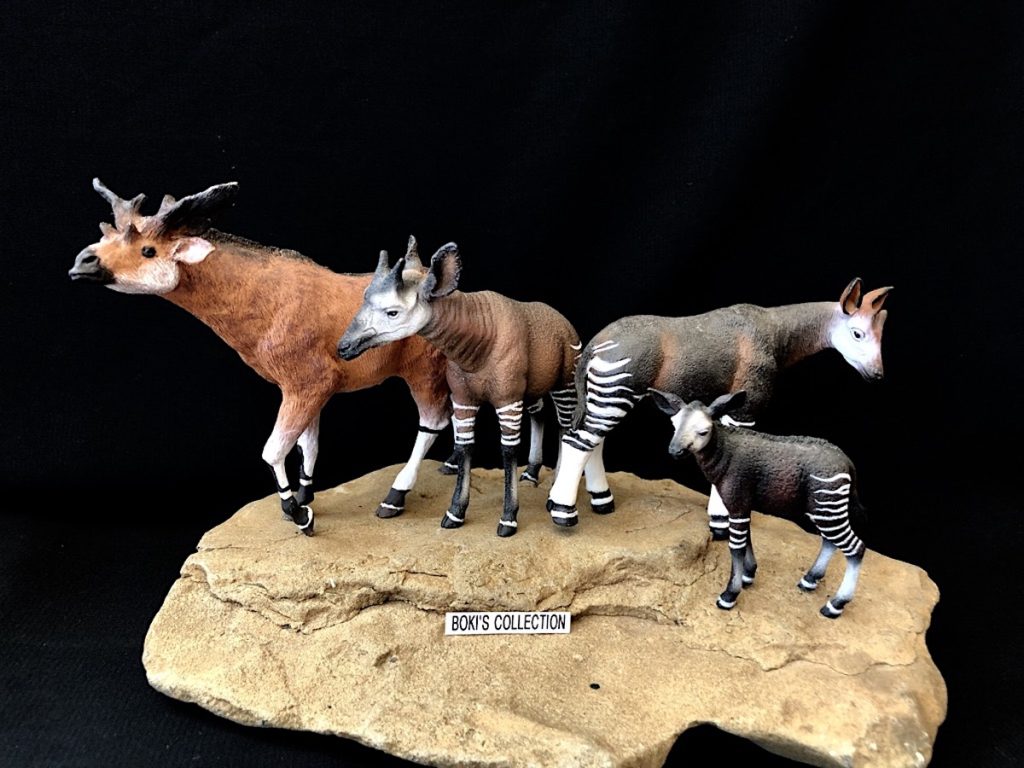
The Okapi share this body design with its extinct relatives, so imagine it on steroids and having a large ossicones and you pretty much have an idea of what Sivatherium may have looked like.
To be able to handle the weight of those large ossicones, Sivatheriums have thick powerful necks. The model faithfully depicts this as the neck is short yet very muscular.
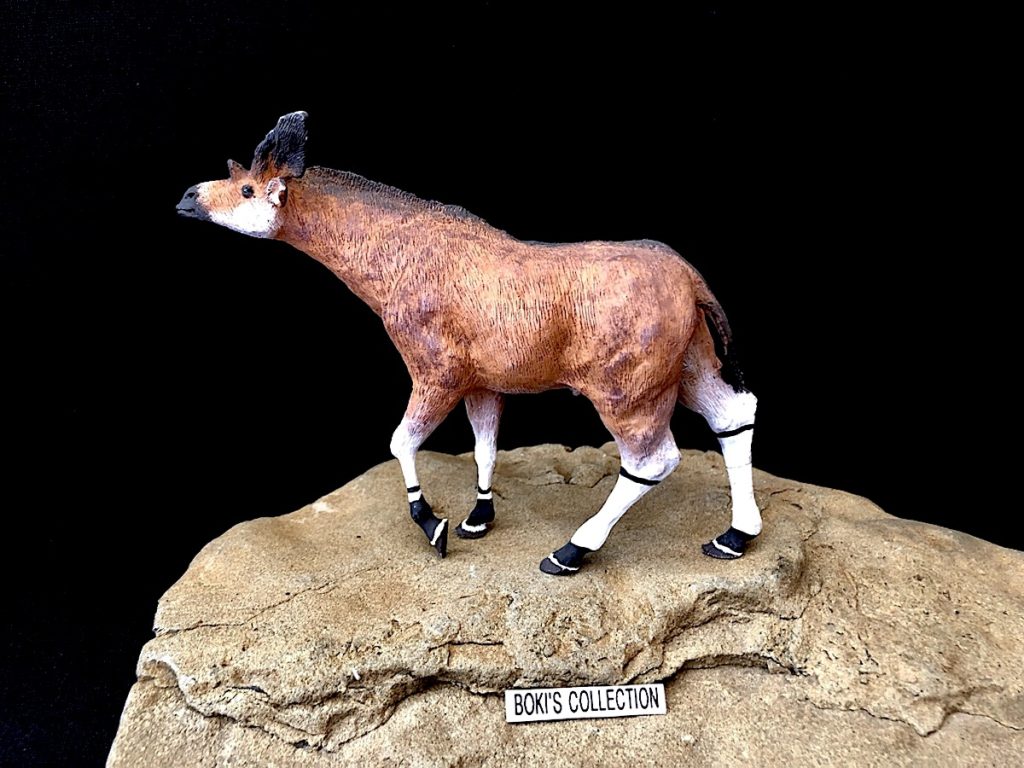
There is a short dark brown mane that runs the length of the neck and terminates just above the shoulders. The dark color continues down the back all the way to the tail.
The head is very well sculpted on this model. It has the unmissable look of a giraffe head. The lips is also very much like that of a giraffe. Right above the eyes, which are painted black, are the first set of short ossicones. This is followed by the much larger and distinctive horns/ossicones on top of the head.This pair fan out sideways like an oversized ears and is flat. Viewed sideway , these pair of ossicones really does look like ears. Viewed front on however one can see two branches on the front of these massive flat ossicones. This points inwards, leaving a squarish gap in-between them.

The face is colored rust brown with white highlights on the cheeks. The muzzle is black with a little bit of white band that separates the black from the brown.
The large ears are also highlighted in white on the inside with dark brown highlights on the outer flaps. The ossicones are painted dark brown on the base and transitions to black as it reaches the halfway point up the ossicones.
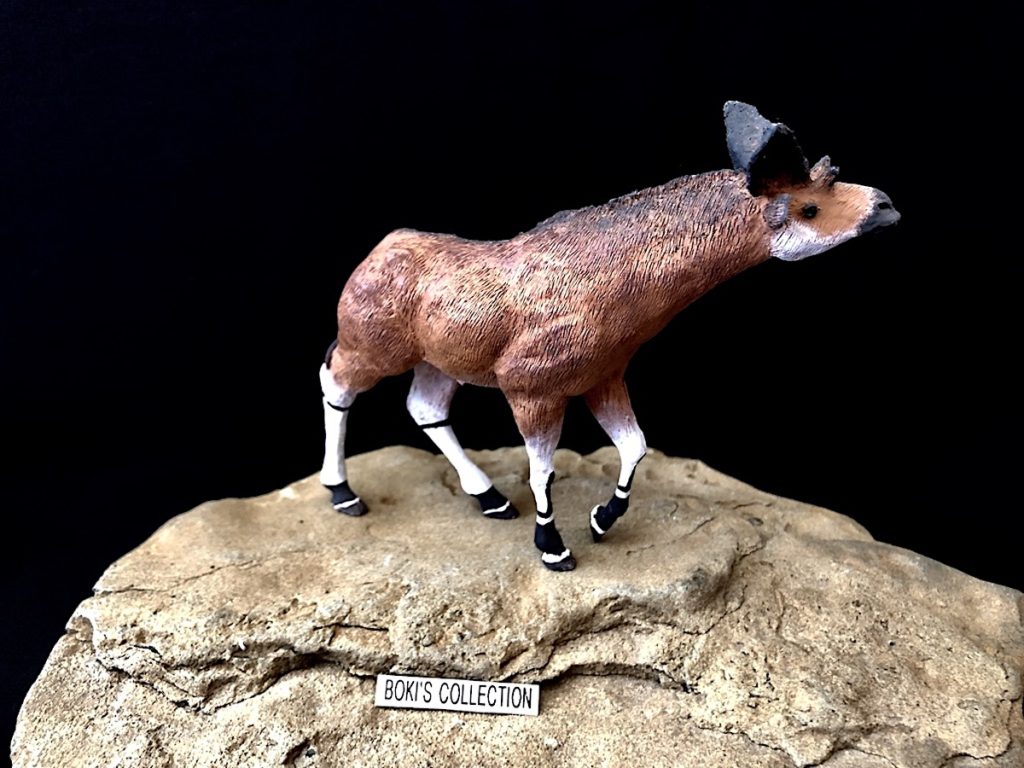
The body is robust and show a lot of muscle definitions all over. The fur texturing is well done as well. There are subtle variations in the hair length, longer on the upper body and shorter on the lower half. This really really gives a nice transition and looks believable.
The front legs are slightly smaller and more slender that the back ones.The overall body color is rust brown with some dark highlights. This transitions to white as it reaches the knees. White dominates from the knee down to the hooves. A black band is seen on the back knees as well as smaller ones on the front. The hooves are black.
The figure is sculpted in 1:24 scale and measures a little over 4.5” inches tall and 5” inches long from the tip of the snout to the back legs.
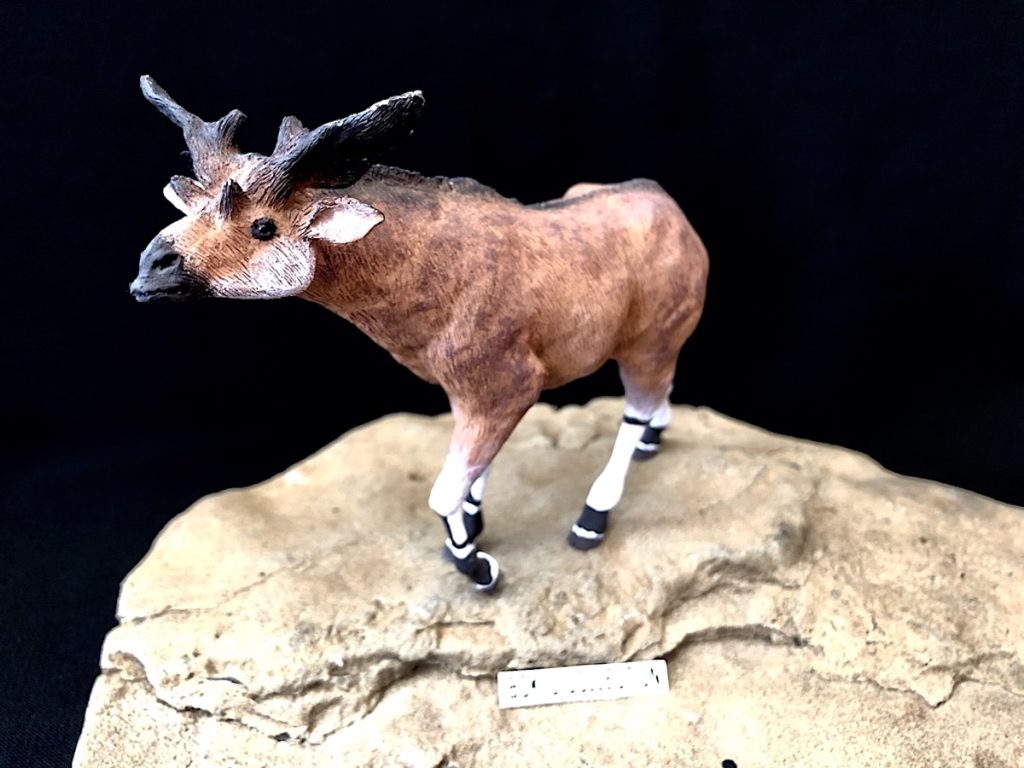
It is posed in a calm way, slowly walking towards some tasty greens. Its legs are firmly planted on the ground with the exception of the front left which is slightly raised.
This pose gives the figure stability, but still be careful about toppling it as the material can be brittle like any resin and may break.
The neck is held out as if the animal is trying to reach for something a little out of reach. Overall, it has a very relaxed and calm demeanor , very regal looking indeed.
After a long existance, from the late Pliocene to the early Holocene, the Sivatherium went extinct. There are speculations that it went extinct as recently as 8,000 years ago as there are some rock art surviving from Africa and India that dates back to around that time that seems to show an animal that greatly resembles a Sivatherium.
So far, no consensus as to why the great Sivatherium went extinct. Perhaps it was a combination of changing climate that disrupted the food source, the cooling temperature, competition, failure to quickly adapt to a rapidly changing landscape, or maybe even hunting pressure from early humans all contributed to its extinction.
With the Sivatherium‘s extinction, the giraffe family lost one of its largest and impressive member. It was also among the last of the many unique species that once roamed the forest and grassland worldwide. Now, all that remains are fossil and maybe some primitive rock art.
I wish I could add a photo of the various prehistoric giraffe figures, but none exist. So, just to illustrate how outrageous the family once was when it came to head ornamentation, I have included one comparison with a figure I sculpted, the Bramatherium, another large and truly impressive beast!

In closing, I am really happy and impressed by this figure. It is the only Sivatherium figure out there that I am aware of besides the small Shapeway one.
For prehistoric animal fans, this is definitely a great piece to beef up those mammal collection.
Most importantly, this is a great way to support artist and their small operation. You can find the model for sale on Etsy, or you can also check out the website Likaon, Where a group of small artist dedicated to producing amazing animal figures.
Unlike mass produced figures, this one is a truly a uniques and one of a kind piece of art and I am very happy to have one in my collection.
Well, I hope you enjoyed this review, thanks for reading and till the next one, cheers!
Support the Dinosaur Toy Blog by making dino-purchases through these links to Ebay and Amazon. Disclaimer: links to Ebay.com and Amazon.com on the The Dinosaur Toy Blog are often affiliate links, when you make purchases through these links we may make a commission

Thanks for a great review! You have single handedly made me want to study prehistoric mammals!
Rob
Thanks, glad you guy like the figure and review.
Prehistoric mammals are so overshadowed by the dinosaurs, but they really are interesting and as odd as the dinosaurs.
What a beauty!
Stunning!
Great to see another Sivatherium review! Well done!